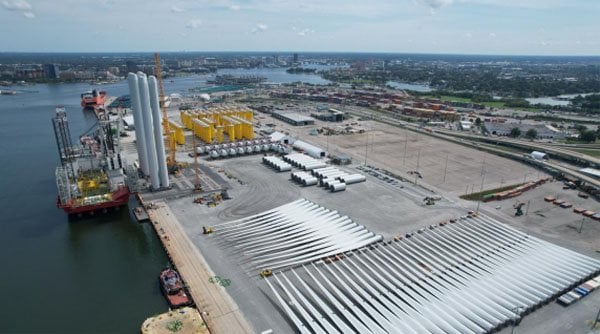Dominion Energy Confirms Commissioning Delays on WTIV Charybdis

As part of its quarterly earnings report to the investment community, Dominion Energy gave a detailed update on commissioning delays with its wind turbine installation vessel Charybis while also emphasizing that the Coastal Virginia offshore wind project remains on schedule and is making good progress. CEO Robert Blue discussed the challenges with the vessel and the overall progress on the project, which he still expects will deliver first power to customers late in the first quarter of 2026.
Calling Charybdis, which is the first American-made Jones Act-compliant WTIV, a “challenge,” Blue went on to tell the investment community, “I am extremely disappointed that Charybdis has again not met expectations… we failed to deliver regarding Charybdis.” He, however, told the audience that he was confident that they would complete commissioning and that the first wind turbine installations would occur late next month (November).
He highlights the uniqueness of the vessel, which he says was built to global best practices but has inherent risk in being the first Jones Act-compliant vessel of its kind built and regulated in the United States.
The vessel, which is 472 feet long and is 27,000 gross tons, was built at Seatrium AmFELS yard in Brownsville, Texas. In its jack-up position, there is a 40-meter (131-foot) air gap under the hull, and its crane has a 2,200-ton capacity. The vessel completed sea trials, received sign-offs, and arrived in Portsmouth, Virginia, in September. Since its arrival, Siemens Gamesa completed necessary modifications for turbine handling and installation, and the vessel underwent new-to-zone inspections in Portsmouth.
Blue said two primary areas of concern were identified during the inspection. First was the material condition of certain components, primarily in the ship’s electrical system. Second was the need for documentation that confirmed that the systems meet US-approved codes and standards. About 200 items were identified that needed to be addressed,
Dominion reports there are about 200 crewmembers and marine electricians working on the ship and doing the additional surveys. To date, they said over 4,000 inspections have been done across 69 electrical systems, including 1,400 cable inspections. Of the 200 items identified on the punch list, about 120 have now been closed out.

Charybdis on dock with the material staged for the offshore wind farm in Portsmouth, Virginia (Dominion Energy)
Dominion says it decided to build the ship, with a cost it now sets at $715 million, because it represented a strategic advantage. They said having their own vessel provided enhanced schedule certainty, which translated to cost certainty for the project. Blue said Dominion continues to believe in the advantages of the vessel.
Through September, they report a total investment of $8.2 billion in the Coastal Virginia project, with remaining project costs attributable to Dominion expected at $1.5 billion.
At this point, 100 percent of the monopiles have been installed, completed one month before the end of the installation season. In addition, 63 transition pieces have been installed, and all 176 are now fabricated. The second substation jacket recently went in, and the topside will be installed shortly. The third offshore substation will be installed in the first quarter of 2026.
First power remains on schedule for about five months from now, and they still expect completion of the project by the end of 2026. However, the delays with Charybdis have meant the company has significantly reduced the schedule for weather and vessel maintenance contingency. Blue said it might result in the final few turbines not being installed until early 2027.
